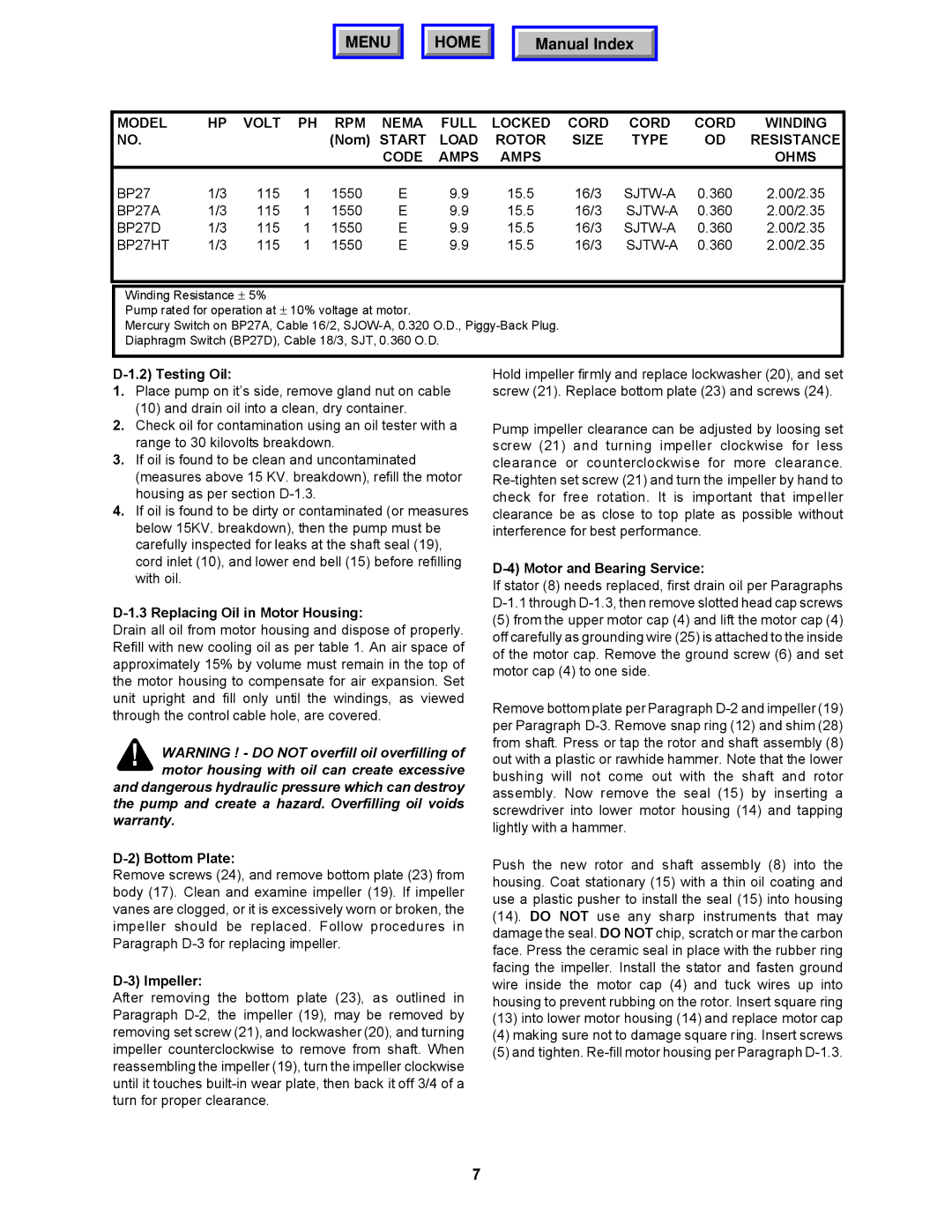
MENU |
HOME |
Manual Index
MODEL | HP VOLT | PH | RPM | NEMA | FULL | LOCKED | CORD | CORD | CORD | WINDING | |
NO. |
|
|
| (Nom) START | LOAD | ROTOR | SIZE | TYPE | OD | RESISTANCE | |
|
|
|
|
| CODE | AMPS | AMPS |
|
|
| OHMS |
BP27 | 1/3 | 115 | 1 | 1550 | E | 9.9 | 15.5 | 16/3 | 0.360 | 2.00/2.35 | |
BP27A | 1/3 | 115 | 1 | 1550 | E | 9.9 | 15.5 | 16/3 | 0.360 | 2.00/2.35 | |
BP27D | 1/3 | 115 | 1 | 1550 | E | 9.9 | 15.5 | 16/3 | 0.360 | 2.00/2.35 | |
BP27HT | 1/3 | 115 | 1 | 1550 | E | 9.9 | 15.5 | 16/3 | 0.360 | 2.00/2.35 | |
|
|
|
|
|
|
|
|
|
|
|
|
Winding Resistance ± 5%
Pump rated for operation at ± 10% voltage at motor.
Mercury Switch on BP27A, Cable 16/2,
Diaphragm Switch (BP27D), Cable 18/3, SJT, 0.360 O.D.
D-1.2) Testing Oil:
1.Place pump on it’s side, remove gland nut on cable (10) and drain oil into a clean, dry container.
2.Check oil for contamination using an oil tester with a range to 30 kilovolts breakdown.
3.If oil is found to be clean and uncontaminated (measures above 15 KV. breakdown), refill the motor housing as per section
4.If oil is found to be dirty or contaminated (or measures below 15KV. breakdown), then the pump must be carefully inspected for leaks at the shaft seal (19), cord inlet (10), and lower end bell (15) before refilling with oil.
D-1.3 Replacing Oil in Motor Housing:
Drain all oil from motor housing and dispose of properly. Refill with new cooling oil as per table 1. An air space of approximately 15% by volume must remain in the top of the motor housing to compensate for air expansion. Set unit upright and fill only until the windings, as viewed through the control cable hole, are covered.
WARNING ! - DO NOT overfill oil overfilling of motor housing with oil can create excessive and dangerous hydraulic pressure which can destroy
the pump and create a hazard. Overfilling oil voids warranty.
D-2) Bottom Plate:
Remove screws (24), and remove bottom plate (23) from body (17). Clean and examine impeller (19). If impeller vanes are clogged, or it is excessively worn or broken, the impeller should be replaced. Follow procedures in Paragraph
D-3) Impeller:
After removing the bottom plate (23), as outlined in Paragraph
Hold impeller firmly and replace lockwasher (20), and set screw (21). Replace bottom plate (23) and screws (24).
Pump impeller clearance can be adjusted by loosing set screw (21) and turning impeller clockwise for less clearance or counterclockwise for more clearance.
D-4) Motor and Bearing Service:
If stator (8) needs replaced, first drain oil per Paragraphs
(5)from the upper motor cap (4) and lift the motor cap (4) off carefully as grounding wire (25) is attached to the inside of the motor cap. Remove the ground screw (6) and set motor cap (4) to one side.
Remove bottom plate per Paragraph
Push the new rotor and shaft assembly (8) into the housing. Coat stationary (15) with a thin oil coating and use a plastic pusher to install the seal (15) into housing (14). DO NOT use any sharp instruments that may damage the seal. DO NOT chip, scratch or mar the carbon face. Press the ceramic seal in place with the rubber ring facing the impeller. Install the stator and fasten ground wire inside the motor cap (4) and tuck wires up into housing to prevent rubbing on the rotor. Insert square ring
(13)into lower motor housing (14) and replace motor cap
(4)making sure not to damage square ring. Insert screws
(5)and tighten.
7
